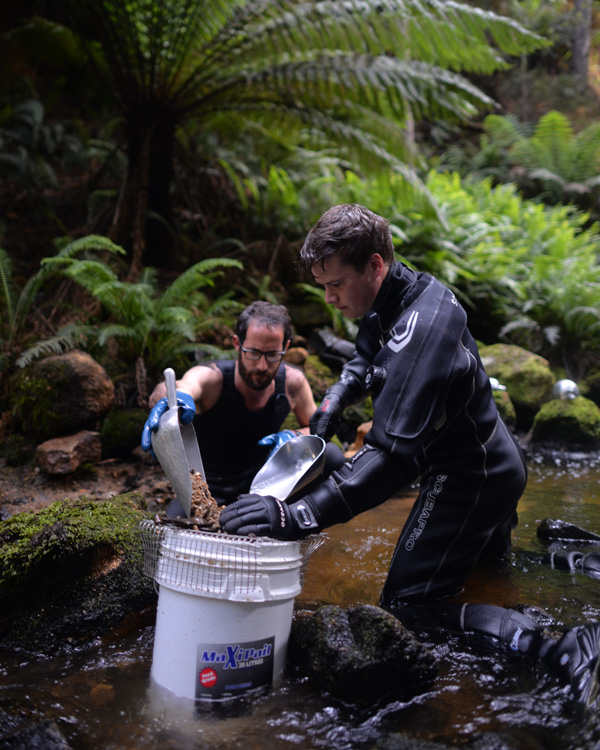Searching for Sapphire in the Tasmanian Wilderness
March 20, 2015
Twentieth century Australian tin miners came across a deposit of material that was very different − and much more colorful − than what they expected: fine blue, green and yellow sapphire.
GIA field gemologists journeyed to the deposit near Weldborough in North Eastern Tasmania in 2012 and 2013 to gather samples for GIA’s reference collection, which is used for the Institute’s research and education programs. Field researchers went back to the Tasmanian wilderness in early 2015, bringing along the newest member of their team for hands-on training.
“The best way we can determine where a reference sample is from is to mine it ourselves,” said Vincent Pardieu, GIA’s senior manager of field gemology. “Knowing how to efficiently mine sapphires from a stream is a great skill for any field gemologist to have.”
Outfitted in wet suits and using traditional hand tools, the field gemologists worked tirelessly for three days in a stream surrounded by lush vegetation. They collected more than 200 sapphire samples, all of the basalt-related type, which are mostly blue with some yellow and green samples. In addition to sapphire, the team uncovered black spinel, zircon and topaz in the gravels.
“Digging for sapphire in Tasmania was tough, but extremely fascinating and rewarding,” said Stanislas Detroyat, a field gemology trainee at GIA. “I learned where to find sapphires in secondary deposits and felt the excitement of finally getting a sapphire from the field in my hands.”
Detroyat and Pardieu were accompanied by Didier Barriere Doleac, videographer; Chris Hood, gemologist and jeweler for Metal Urges in Tasmania; and expedition guests Eleonore Tatou, Marjorie Michel and Benjamin John. The team also had the opportunity to meet with Khin Zaw, research professor at the University of Tasmania, and Brendan M. McGee, a copper miner in Western Tasmania who wrote a thesis about Tasmanian sapphire under Professor Zaw’s supervision.
Background
In keeping with its mission to ensure the public trust in gems and jewelry, GIA regularly conducts research field trips to important gem and jewelry centers around the globe, incorporating findings into research practices and education programs and providing information to the trade and public. GIA appreciates the access and information provided during these visits; however, they should not be taken as or used as a commercial endorsement. Findings from the Tasmania field trip will be featured in an upcoming issue of G&G, as well as in field reports and video documentaries on the website.
Kristin Mahan, a manager on GIA's communications team, is an Accredited Jewelry Professional.









